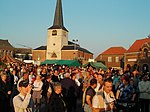Hazewinkel

The Hazewinkel is a 2,000 m rowing and regatta course belonging to Bloso in Heindonk, municipality of Willebroek, near Mechelen, Belgium. The site consists of a finishing tower, boathouses, a cafeteria and eight basic huts that house athletes using the lake. The course hosted the Great Britain Rowing team's national final trials for some years and, in July 1996 and 2006, the World Rowing Under 23 Championships too. It has also hosted two World Rowing Championships (1980, 1985) as well as the World Rowing Junior Championships (1997). An accessible wetland nature reserve borders the south side. Boats under 5 metres length sail on a lake just to the north at 'De Bocht' with the VVW-Hazewinkel Club (founded 1978). This lake also serves members of the Hazewinkel Windsurfing Club, which welcomes visitors for a day.
Excerpt from the Wikipedia article Hazewinkel (License: CC BY-SA 3.0, Authors, Images).Hazewinkel
Grote Bergen,
Geographical coordinates (GPS) Address Nearby Places Show on map
Geographical coordinates (GPS)
| Latitude | Longitude |
|---|---|
| N 51.066 ° | E 4.393 ° |
Address
Grote Bergen 9
2830
Antwerp, Belgium
Open on Google Maps









